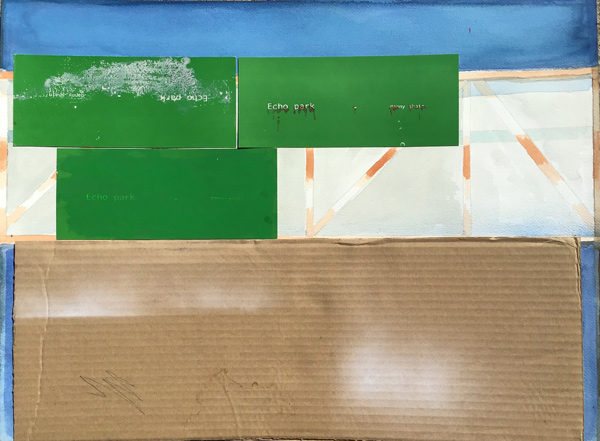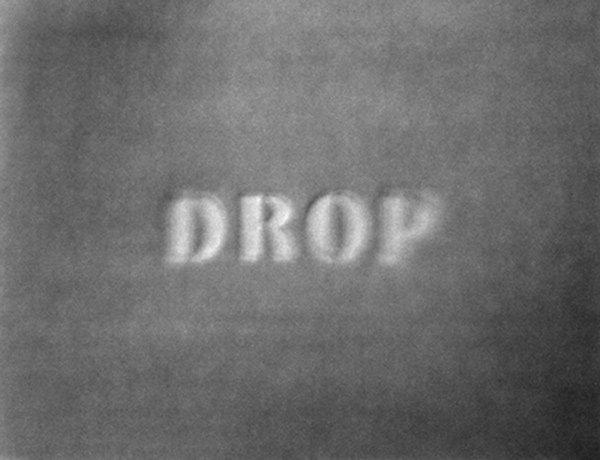George Braque’s simple act of stenciling the words “BAL” and “BACH” onto two of his Analytic Cubist paintings in 1911 launched a trend in modern and contemporary art so pervasive, there is no way he could have imagined the ramifications. The use of text in art has since evolved into a kind of style, one that seems inexorably linked to Conceptualism, although contemporary artists utilize it in an infinite variety of ways. “Medium,” curated by Carolie Parker, features the work of six Los Angeles artists who explore the conflation of images and words, or words as images. The exhibition coheres visually, despite the variety of mediums and visual styles, ranging from photography to drawing, painting, sculpture and video.

Danny Shain, Echo (2005). Courtesy of the artist and FOCA.
Danny Shain’s collaged and painted works are wistful responses to the Southern California landscape, the progeny of Richard Diebenkorn’s Ocean Park paintings, but grittier, evoking freeway signs and urban infrastructure. They hover in a purgatory between image and abstraction, functioning as both formalist balancing act and subconscious signifier. The works of Anne Seidman also deal with rectilinear geometric abstraction, but her complex concatenations of colored rectangles are the visual antithesis of Shain’s minimalist sensibility, seemingly multiplying and spreading across white backgrounds like crystal growth. For both artists, text is a minor, yet important element, a foil to the literalness of the abstract geometry.

Anne Seidman, Untitled (2019). Courtesy of the artist and FOCA.

Laura Parker, cOOl (from Star Writing Series), 2011. Courtesy of the artist and FOCA.
Text is more prominent in the photographic work of Laura Parker, who creates dazzlingly distorted letters by fixing the camera on stars and planets, then moving it while the lens is open. Parker interjects humor into the use of text, spelling out words such as “cool” and “ok” in the cosmos, recalling John Baldessari’s California Map Project (1969). Humor is also key in the porcelain sculpture of Thomas Müller, whose sagging, crumbling three-dimensional words as sculpture stating phrases like “eye candy” makes one think of both the staggering communicative power that words possess, yet their frequent inability to effectively express thoughts and feelings.

Carole Kim, Forest’s Edge (2018). Courtesy of the artist and FOCA.
Ginny Cook and Carole Kim share an ability to evoke a kind of visual poetry with words. Cook’s exploration of sleep state misperception, in which one loses the ability to differentiate between wakefulness and sleep, produces some haunting images, such as the word “drop” shown in an exceedingly grainy silver gelatin print, evoking that singular moment when one slips into a state of slumber. Kim shows photographs of projections of words onto trees, fragmenting the text and obscuring its legibility and meaning, and a related work, an intriguing minuscule house-like sculpture with a video projection.

Ginny Cook, Sleep State Misperception (Drop), 2014/2019. Courtesy of the artist and FOCA.
Collectively, the artists in “Medium” demonstrate the continued viability of the combined power of words and pictures in the gallery context, while providing an antidote to the sometimes preachy and didactic use of text in current art.
“Medium,” curated by Carolie Parker, January 6 – March 15, 2019, at Fellows of Contemporary Art, 970 N. Broadway, Suite 208, Los Angeles, CA, 90012. focala.org



















I didn’t know who was the first to use text in contemporary painting. Interesting, now I have to find out why.